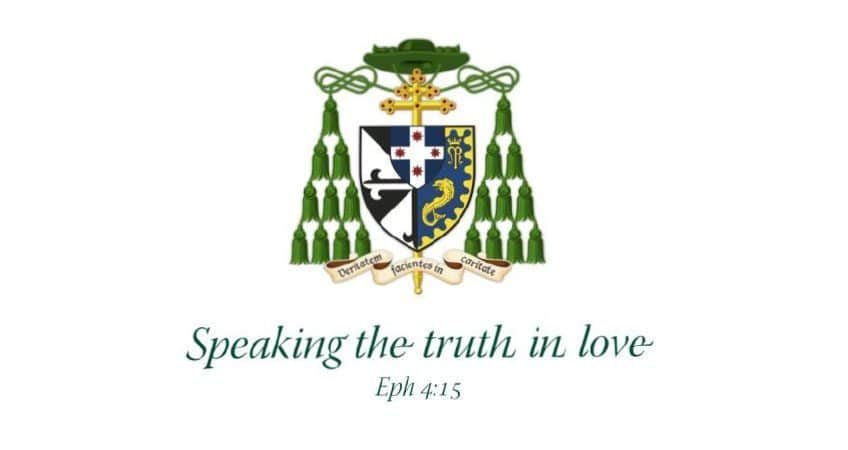HOMILY FOR THE BLESSING OF THE TRIPTYCH

Our Lady Seat of Wisdom Chapel, ACU North Sydney Campus
Today we bless a new work of sacred art, The Mother of Divine Wisdom with St Joseph and St Mary of the Cross MacKillop, created by Chiara Perinetti Casoni, whom we welcome today to Australia and celebrate in the University. She is to be congratulated: bravissima signora!
The Australian Catholic University is also to be applauded for commissioning this work and for its contributor to the cultural life not only of its students but of the wider Church and community. Congratulations to the Hon. John Fahey AC, Chancellor of the University; Prof. Greg Craven AO, GCSG, Vice-Chancellor and President; Deputy Vice-Chancellors Hayden Ramsay and Zlatko Skrbiš; Dr Stephen Weller, Chief Operating Officer; deans, professors, other leaders and staff. I acknowledge also my fellow senators and the student choir from Loreto Kirribilli.
Risky as it is to do so in front of Signora Casoni herself, let me now attempt a theological interpretation of this work…
The Mother of Divine Wisdom with St Joseph and St Mary MacKillop was installed in the Chapel of Our Lady Seat of Wisdom of the Australian Catholic University and blessed on 13 June 2019. At the top of our triptych is the Holy Spirit in the form of a dove, surrounded by three seraphim. This echoes frames of Taddeo de Bartolo in whose tradition the painter Chiara Perinetti Casoni has followed. The Spirit is above all, creating, sustaining, redeeming, inspiring. He is the source of that Wisdom of which Mary is mother and seat. He is the efficient cause of that Incarnation by which Wisdom takes her flesh in Jesus. And He is an intimation of that dove that appears in the St Joseph legend, to which I shall return.
The seraphs surrounding the dove are three of nine flame-winged Angels who appear in the work. With the golden grounding they emphasize the transcendent goal of all worship. Four attend the Madonna and Child, two adoring and two kneeling, as if supplicants, modelling the posture for the congregation. As if in a sung litany, they proclaim the Virgin “Mater Divinæ Sapientiæ”, to which we all respond “Ora pro nobis”. “Mother of divine wisdom – pray for us.” I’ll not trouble you with a long discourse on angelology: suffice it to say that Christians believe in a much richer ecology than just what we can see, measure and control; that there are many spiritual creatures worshipping in heaven and on earth; and that some of these are assigned to guard and guide us.
On the side-panels are Joseph and Mary MacKillop, patron saints of the Josephite Order. As this university succeeds a Josephite teaching college on the site and is geographically proximate to the saint’s final resting place, our triptych effectively claims the two as patrons of the University. Both Mary MacKillop and Julian Tennison-Woods, it should be said, loved St Joseph; in their Rule they proposed the companionable relationship of the Holy Family as a model for the Sisters’ life and ministry. In the present work, Joseph models for us wonder and adoration, as he stares towards Mother and Child. Meanwhile MacKillop looks out to us, drawing us into the work. She was an educational adventurer and extraordinary organiser; he had a Son who thought He was God and a wife who believed Him, and had to manage them both! The two therefore offer particular good example to our University leaders.
Of his many titles in the tradition, the one for which St Joseph is named in his halo is ‘husband of Mary’, and thus Protector of the Holy Family. He is dressed in purple, which in Christian iconography represents royalty (through Joseph, Jesus is joined to the royal line of David) and penance (both Joseph and Jesus embrace poverty and celibacy).
Joseph is holding a staff. It might be read as a pilgrim’s walking staff, for he brought the Holy Family to Bethlehem, to Egypt, to Nazareth, and to and fro Jerusalem. But there is more to this traditional symbol for Joseph. In chapter 17 of the biblical Book of Numbers God directs each tribe of Israel to make a rod with the names of its men, and place it in the Tent of Meeting; one rod – the rod of Aaron for the House of Levi – flowers, indicating that theirs shall be the priestly line. Thus Joseph’s rod is a sign of his being chosen from the Levitical line.
There is more. The 2nd-century Protoevangelium of James, with its legends of Jesus, Mary and Joseph, was followed in the standard book of Christian hero stories composed by a mediæval Dominican archbishop like myself, James of Varagine. The Golden Legend informed much subsequent sacred art. Both works told how the child Mary served in the Temple until adolescence when the council of priests decided to marry her off. An angel suggested the high priest summon all the widowers to the Temple and bring their rods. When St. Joseph – in our painting, with the greying hair of a widower – presented his staff, it flowered like Aaron’s, and a dove flew out of it and settled upon his head. This indicated that Joseph had been chosen to be betrothed to Mary. So there’s a lot packed into Joseph’s walking stick: in Renaissance art it evolved further, into a lily of chastity.
In our triptych Joseph has hand on heart as if pledging himself to the Holy Family’s care. According to Scripture and Tradition he is just, chaste, prudent, strong, obedient, faithful, patient, hard-working… always true to his pledge.
On the opposite panel is St Mary McKillop, the first canonised saint of Australia and patron of Catholic schools and school teachers – many of whom are trained at this university. Here she is dressed in the habit of her order, the Sisters of St Joseph; because it was brown, they were known as ‘Brown Joeys’. The blue emblem that looks like the monogram of the Australian Broadcasting Commission goes back to the founding of the order in 1866: it combines the letters A and M from “Ave Maria”, with 3 little Js in honour of Jesus, Joseph and John the Baptist.
MacKillop’s halo, hand cross, and rosary crucifix all point to her name in religion, and to the call to all Christians to take up their cross and follow Christ (Mt 16:24-6 etc.). In her other hand is the scroll of a teacher of wisdom and rule-giver to her congregation. That rule proposed the evangelical counsels lived for the education of the poor and relying entirely upon divine providence.
A Madonna and Child fill the central panel. On the halo and the cartiglo, the Madonna is praised as “Mother” or “seat” of divine wisdom. Under this title she is Patron of Catholic universities, including this one. But there is ambiguity here, as in the phrase ‘love of God’: does it mean our love of God or God’s love in us? So, too, Mary is Mother of the One who is divine wisdom incarnate, but she is also a divinely wise Mother.
As stars featured in our reading today (Rev 11:19-12:10), there is a star on the Madonna’s right shoulder, symbol of another ancient title, Stella Maris. This honours Mary’s long-pondered wisdom and the compass she is to devoted seamen and, indeed, devoted scholars. The star upon a sea of blue might also be thought to hint at our campus’ Sydney Harbour geography.
The Madonna holds the Scriptures in her right hand and the Christ child in her left: both are the Word, spoken from all eternity by the Father as the Son, and spoken in time through divine revelation and the Incarnation of Jesus. In and even before the Annunciation, Mary learnt her calling from that Word.
Mary is dressed in glorious lapis lazuli blue over a red robe, colours associated with royalty in the ancient world and her official colours by the early Renaissance. On one reading, the blue comes from the Book of Numbers (Num 15:38-39) where it is associated with a blue girdle of obedience and purity, and with the blue covering over the Ark of the Covenant and Table of the Presence (Num 4:6-7). Red is associated with love and passion, devotion and sacrifice.
At the centre of the triptych the eye is drawn to the Christ Child – God enfleshed as a chubby Northern Italian bambino. If the Woman in whose lap He sits is the Seat of Wisdom, then He is Wisdom incarnate. With one hand He points to the Holy Scriptures, for He is the Word made flesh and inspiration of the sacred page. With the other He holds a crystalline orb for He is Christ the King whose ‘kingdom come’ in our Christian worship and contemplation, theology and action. For all His grandeur, there is an intimacy with the Mother and with the viewer, a sense of family, security, nurture. St Luke tells in his Gospel that after the boy grew to adolescence and was lost amongst the Temple professors, He “returned with his parents to Nazareth, and was obedient to them. His mother treasured all these things in her heart. And Jesus increased in wisdom and stature, and in favour with God and man.” (Lk 2:51-52) So, too, may our students be docile to learning, grow in a deeper wisdom, and earn the respect of their fellows.
It is for devotees amongst the University’s leaders, staff, students and friends to take forward this exegesis I have offered today, even as this triptych draws them to contemplation, collaboration and communion. It is for them to prepare that ‘place of safety’ (Rev 11:19-12:10) for the Mother of Wisdom in our country, in our university and in our hearts. May this Alma Mater or ‘nourishing mother’ keep us safe from the serpent who is the Great Liar, and make our minds, like hers, seats for Holy Wisdom.

